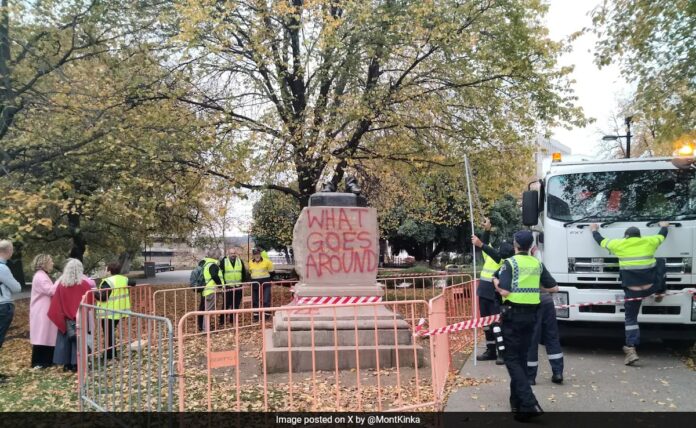William Crowther’s statue has divided the city of Hobart.
Over 150 years ago, surgeon and politician William Crowther allegedly stole the skull of an Aboriginal leader, William Lanne, from a Hobart morgue. Today, the crime continues to spark debate in the city as the statue of Crowther, once towering over a central square, lies in ruins – its feet severed by vandals.
In the heart of Hobart, Tasmania, the bronze monument once stood over the oak-lined square. The statue, earlier, was cut down at the ankles, leaving only severed bronze feet behind, the BBC reported. The vandalism, along with the words “what goes around” spray-painted on its base, symbolised a larger struggle – a debate about colonialism, racism and the dark history of Tasmania’s treatment of its Aboriginal people.
William Crowther’s notoriety stems from an event that took place over 150 years ago, when he allegedly broke into a morgue and mutilated the body of William Lanne, an Aboriginal leader. Lanne’s skull was stolen and later sent overseas as a trophy, which showed the colonisers’ view of Tasmanian Aboriginal people as extinct. Today, Lanne’s descendants and many in the Aboriginal community see Crowther as a symbol of colonial brutality and erasure.
William Lanne, often referred to as the last “full-blooded” Aboriginal Tasmanian, is a symbol of the tragic history of Tasmania’s Indigenous population and their mistreatment by British colonisers. Born around 1835, Lanne was part of the Palawa people, the original inhabitants of Tasmania (formerly Van Diemen’s Land). Lanne was forcibly removed from his homeland and lived through two notorious camps established to confine Aboriginal people. He is remembered as a shipmate and advocate for his people.
William Lanne, once thought to be the last Aboriginal man in Tasmania, became the subject of scientific exploitation. He died at the age of 34 in 1869 due to disease. Before his burial in 1869, parts of his body, including his hands, feet and skull, were stolen by physicians eager to study the so-called “missing link” between humans and Neanderthals. Though Crowther denied involvement, the scandal rocked the city at the time, leading to his suspension from the hospital.
For Aboriginal activists, like Nala Mansell, the statue of William Crowther represented not just a man but the false narrative that Aboriginal Tasmanians were wiped out. In contrast, some Hobart residents, including Crowther’s descendants, see him as a significant historical figure whose contributions should not be overshadowed by past misdeeds.




